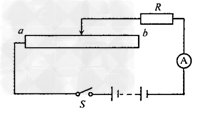问题
计算题
如图是利用滑动变阻器控制电流的电路,其中电阻R 为100 欧姆,它与滑动变阻器串联在电路中,通过电阻的电流可在10 毫安~100 毫安范围内调节。
(1)选用电源的电压应为多大?
(2)变阻器的总电阻为多大?额定电流至少要多大?
(3)上述电路能否使电阻R两端的电压调为零?请说明理由。

答案
解:
(1)由于电阻R 的大小为100 Ω ,当滑变接入为0 Ω 时,电流表示数最大为100 毫安,则电源电压为U=RI=10V;
(2)当滑动变阻器最大时,电流表示数最小,
则R 总=U/I=10V/0.01A=1000 Ω,
R滑=R总-R=1000-100-900Ω
由于电流表可在10 毫安~100 毫安范围内调节,则滑动变阻器的额定电流至少需要100 毫安。
(3)不能,由U= 可知当R 滑增大时,U 将减小,当R 滑达到最大值900 欧时,U 取到最小值1V ,不能取到0。
可知当R 滑增大时,U 将减小,当R 滑达到最大值900 欧时,U 取到最小值1V ,不能取到0。
